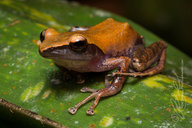|
Description
Males 32-45 mm, females 35 mm. Tibiotarsal articulation reaches between eye and nostrils. Hands without webbing, foot webbing 1(1), 2i(1), 2e(0.5), 2i(2), 3e(1), 4i/e(2), 5(1). Dorsal skin smooth. Dorsally of variable colouration, but often with a laterally uniform dark brown head; similar morphologically to G. kathrinae (Glaw and Vences 2007).
Distribution and Habitat
Country distribution from AmphibiaWeb's database: Madagascar
Andasibe, Andrangoloaka, Mandraka, Ranomafana, Sahembendrana, Tsarafidy.
It occurs from sea level up 1200 m (Nussbaum et. al 2008). Life History, Abundance, Activity, and Special Behaviors
Habits: A relatively explosively breeding arboreal frog. Males call at night from the vegetation, 1-2 m above ponds in or near rainforest. Mating takes place on vertical leaves overhanging the water; the male positions himself over the female and rubs her shoulders and head with the underside of his shanks.
Calls: A single note of 1-7 rapidly repeated pulses.
Eggs and Tadpoles: Eggs are bright white and after some time the whole clutch fuses to a whitish non-transparent jelly mass. The (pigmented) hatching tadpoles complete their development in the pond. Trends and Threats
This species is listed as least concern in view of its wide distribution, tolerance of a degree of habitat modification, presumed large population, and because it is unlikely to be declining fast enough to qualify for listing in a more threatened category. It does not survive in completely open areas and occurs in many protected areas. Its forest habitat is receding due to subsistence agriculture, timber extraction, charcoal manufacture, and invasive spread of eucalyptus, livestock grazing and expanding human settlements. It might also be affected by the collection of Pandanus, which is used for the roofs of huts (Nussbaum et. al 2008). Possible reasons for amphibian decline General habitat alteration and loss
Habitat modification from deforestation, or logging related activities
Intensified agriculture or grazing
Urbanization
Subtle changes to necessary specialized habitat
Comments
Taken with permission from Glaw and Vences (2007).
References
Glaw, F., and Vences, M. (2007). Field Guide to the Amphibians and Reptiles of Madagascar. Third Edition. Vences and Glaw Verlag, Köln.
Nussbaum, R., Cadle, J., and Vences, M. (2008). Guibemantis depressiceps. In: IUCN 2008. 2008 IUCN Red List of Threatened Species. www.iucnredlist.org. Downloaded on 18 March 2009.
Originally submitted by: Miguel Vences and Frank Glaw (first posted 2000-11-27)
Edited by: Michelle S. Koo, Catherine Aguilar (2012-10-08)Species Account Citation: AmphibiaWeb 2012 Guibemantis depressiceps <https://amphibiaweb.org/species/4592> University of California, Berkeley, CA, USA. Accessed Jun 14, 2025.
Feedback or comments about this page.
Citation: AmphibiaWeb. 2025. <https://amphibiaweb.org> University of California, Berkeley, CA, USA. Accessed 14 Jun 2025.
AmphibiaWeb's policy on data use.
|
